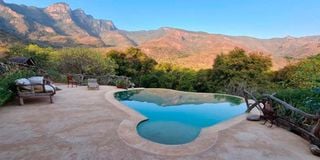Up in the trees in Samburuland

Sarara Treehouses pool area.
What you need to know:
- I have visited the main Sarara Camp and the nearby Reteti Elephant Sanctuary numerous times over the years, both privately and with safari clients.
- However, I had yet to experience their newest offering — the Sarara Treehouses.
The ‘Sarara Valley’, on the eastern side of the Matthews Mountain Range, is a broad enclave surrounded by the hills north of Mt Ololokwe. For the past 20 years, the resident Samburu community has successfully incorporated eco-tourism and conservation into their valley, which forms part of the larger Namunyak Community Conservancy.
I have visited the main Sarara Camp and the nearby Reteti Elephant Sanctuary numerous times over the years, both privately and with safari clients. However, I had yet to experience their newest offering — the Sarara Treehouses.
Recently, I was invited back up to Namunyak to run a short consultancy before the resumption of the traditional safari high season, and the team took me across to check it out.
Tucked into a grove of newtonia and diospyros trees, the camp is raised on tall platforms at the canopy level. The elevated walkways connect all the rooms and allow you to look down at elephant pathways and waterholes that are frequented by a whole host of wildlife species, especially in the dry seasons.
Each ensuite room has a different view and comes with large mesh walls to allow the breeze and sounds of the canopy to filter in. At night, curtains can be drawn for privacy and warmth.
The main ‘mess’ area has a stunning pool and commanding view over the top of the trees toward the tallest peak in the Matthews Range, known locally as ‘Uarges’.
For decades, Sarara guests have enjoyed authentic cultural experiences, including visits to local villages and intimate access to Samburu ‘Singing Wells’. The wildlife species in the valley have also rebounded after decades of poaching pressure.
Chain of ‘sky islands’
Reticulated giraffe, considered critically endangered, now number over 400 in the area. The Reteti Elephant Sanctuary, which rescues orphaned and abandoned elephants from northern Kenya, is also a regular stop for Sarara guests.
However, for birders, botanists and walkers, the area offers even more. As you gain elevation up the hills, the semi-arid savannah quickly makes way for broad-leaved trees and eventually forests.
The hills are over half-a-billion years old, and have weathered down to create a chain of ‘sky islands’, surrounded by a sea of semi-arid savannah, isolated from other forest habitats. As a result, there have evolved endemic species of butterfly, cycad and no doubt many more organisms, found nowhere else in the world.
The Sarara Treehouses are ideally located to explore the hills and the varied habitats. The team and I hiked up from the lodge for about an hour to reach a famous flat rock, smoothed out by millions of years of water erosion emanating from springs further up.
Already the birdlife had changed, with forest species such as trogons and turacos suddenly present. If we had pushed onwards another hour or so, we would have reached the cycads and begun seeing new mammal species such as colobus monkeys.
Currently, Sarara Treehouses has special rates for residents and citizens. It takes about seven to eight hours to drive there from Nairobi, so it is really worth spending at least three nights to make the journey worthwhile.
Outside of the rainy seasons, the Sarara Valley is easily accessible for anyone with a car with good ground clearance. The drive to Sereolipi town takes about six hours from Nairobi, and then Sarara Treehouses is another 90 minutes or so along dirt roads from there.
The new sarara.co website (.co not .com) gives all the relevant details about the lodges, foundation and Reteti. An enquiry for a stay at the Treehouses can be made at [email protected]
Andreas is managing director at Mbweha Training and Trails





